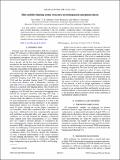Hole-mobility-limiting atomic structures in hydrogenated amorphous silicon
Author(s)
Buonassisi, Tonio; Grossman, Jeffrey C.; Johlin, Eric Carl; Simmons, Christie B.
DownloadPhysRevB.90.104103.pdf (883.5Kb)
PUBLISHER_POLICY
Publisher Policy
Article is made available in accordance with the publisher's policy and may be subject to US copyright law. Please refer to the publisher's site for terms of use.
Terms of use
Metadata
Show full item recordAbstract
Low hole mobility currently limits the efficiency of amorphous silicon photovoltaic devices. We explore three possible phenomena contributing to this low mobility: coordination defects, self-trapping ionization displacement defects, and lattice expansion allowing for hole wave-function delocalization. Through a confluence of experimental and first-principles investigations, we demonstrate the fluidity of the relative prevalence of these defects as film stress and hydrogen content are modified, and that the mobility of a film is governed by an interplay between various defect types.
Date issued
2014-09Department
Massachusetts Institute of Technology. Department of Materials Science and Engineering; Massachusetts Institute of Technology. Department of Mechanical Engineering; Massachusetts Institute of Technology. Research Laboratory of ElectronicsJournal
Physical Review B
Publisher
American Physical Society
Citation
Johlin, Eric, C. B. Simmons, Tonio Buonassisi, and Jeffrey C. Grossman. "Hole-mobility-limiting atomic structures in hydrogenated amorphous silicon." Phys. Rev. B 90, 104103 (September 2014). © 2014 American Physical Society
Version: Final published version
ISSN
1098-0121
1550-235X